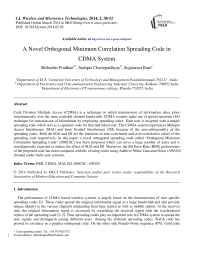A Novel Orthogonal Minimum Correlation Spreading Code in CDMA System
Автор: Shibashis Pradhan, Sudipta Chattopadhyay, Sujatarani Raut
Журнал: International Journal of Wireless and Microwave Technologies(IJWMT) @ijwmt
Статья в выпуске: 2 Vol.4, 2014 года.
Бесплатный доступ
Code Division Multiple Access (CDMA) is a technique in which transmission of information takes place simultaneously over the same available channel bandwidth. CDMA systems make use of spread spectrum (SS) technique for transmission of information by employing spreading codes. Each user is assigned with a unique spreading code which acts as a signature code for that individual user. The CDMA system experiences Multiple Access Interference (MAI) and Inter Symbol Interference (ISI) because of the non-orthogonality of the spreading codes. Both the MAI and ISI are the functions of auto-correlation and cross-correlation values of the spreading code respectively. In this paper, a novel orthogonal spreading code called “Orthogonal Minimum Correlation Spreading Code” (OMCSC) has been proposed which can serve a large number of users and is simultaneously expected to reduce the effect of MAI and ISI. Moreover, the Bit Error Rate (BER) performance of the proposed code has been compared with the existing codes using Additive White Gaussian Noise (AWGN) channel under multi-user scenario.
BER, CDMA, MAI, ISI, OMCSC, AWGN
Короткий адрес: https://sciup.org/15012862
IDR: 15012862
Список литературы A Novel Orthogonal Minimum Correlation Spreading Code in CDMA System
- Dixon R.C. (1976). Spread spectrum systems, John Wiley & Sons, Inc.; New York.
- AJ. Viterbi. (1 995). CDMA Principles of Spread Spectrum Communication, Addison-Wesley.
- Esmael H. Dinan & Bijan Jabbari, (Sep. 1998).” Spreading codes for direct sequence CDMA and wideband CDMA cellular networks”, IEEE Communication Magazine.
- Moshavi, S. (1996). Multi-user detection for DS-CDMA communications. IEEE Communications Magazine, 34(10), 124–136.
- Sarwate, D. V., & Pursley, M. B. (1980). Crosscorrelation properties of pseudorandom and related sequences. Proceedings of the IEEE, 68(5), 593–619.
- Jianxin,B., Yingmin, W., Hongxin, T., & Kechu, Y. (2000). A new method to design CDMA spreading sequences. International Conference on Communication Technology Proceedings, WCC - ICCT 2000(Vol. 1, pp. 526–529).
- Develi, I. (2004), Detection of optimal spreading codes for DS-CDMA wireless systems with dispreading sequences weighted by adjustable chip waveforms, Science Direct Journal, vol. 342, no. 1, pp. 69-84.
- Wu, Z., & Nassar, C. R. (2002). Novel orthogonal codes for DS-CDMA with improved cross correlation characteristics in multipath fading channels. The 5th International Symposium on Wireless Personal Multimedia Communications (Vol. 3, pp. 1128–1132).
- Amayreh, A. I., & Farraj, A. K. (2007). Minimum autocorrelation spreading codes. Wireless Personal Communications, 40(1), 107–115.
- Farraj, A. K., & Amayreh, A. I. (2009). Minimum cross correlation spreading codes. Wireless Personal Communications Journal, 48(3), 385–394.
- Farraj, A. K. (2010) Minimum correlation spreading codes design. Wireless Personal Communications Journal, 55, 395–405.
- H. Donelan and T.O’ Farrell, “Methods for generating sets of orthogonal sequences’’, Electronics Letters, vol. 35, no. 18, pp. 1537-1538, September 1999.
- A. Chandra and S. Chattopadhyay, “Small set orthogonal Kasami codes for CDMA system”, in Proc. Computers and Devices for Communication (CODEC-2009), Kolkata, December 2009.
- A.N. Akansu and R. Poluri, “ Walsh-like nonlinear phase orthogonal codes for direct sequence CDMA communications”, IEEE Transactions on Signal Processing, vol. 55, no.7, pp. 3800-3806, July, 2007.
- P. Fan and M. Darnell, Sequence Design for Communication Applications, U.K.: Research Studies Press, 1996.
- R. Gold, "Optimal Binary Sequences for Spread Spectrum Multiplexing," /€€€ Trans. Info. Theory, vol. IT-B, Oct. 1967, pp. 619-21.
- R. Gold, "Maximal Recursive Sequences with 3-Valued Recursive Cross-Correlation Functions," /€E€ Trans. Info. Theory, vol. IT-4, Jan. 1968, pp. 154-56.
- T. Kasami, "Weight Distribution Formula for Some Class of Cyclic Codes," Coordinated Science Lab., Univ. IL, Urbana. Tech. Rep., R-285, Apr. 1966.
- S.K.Mitra, Digital Signal Processing: A Computer Based Approach, McGraw Hill, 2001.
- Proakis, J. G., and Manolakis, D. G. (1996), Digital Signal Processing: Principles, Algorithms, and Applications, 3rd Edition, Prentice Hall.


